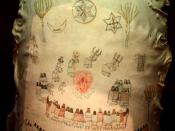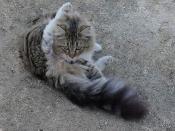I. Classify using Van Gennep's categories and point out aspects which would be of
particular interest to Turner and to Chapple and Coons.
The Mescalero girls' puberty ceremony is an example of a 'Rite of Passage,' a ceremony
that marks the transition of an individual from one stage of life to another (Chapple and Coons,
p. 484). The ceremony marks the transition from girl to 'mother of a nation' (p.252). The ritual
serves as a means of establishing equilibrium after the crisis of puberty (Chapple and Coons, p.
484). It is a method of making this transition from girl to woman easier. I classified this
ceremony as a Rite of Passage, rather than a Rite of Intensification, because it is held in
response to a non-periodic change (puberty) and it affects the participants individually. The
community plays an important role in supporting the girls-by building the tepee, for instance.
At
times, as when the boys join the Singers, the community actively participates in the ritual.
However, the community is involved only because of its members' relations to the girls.
Van Gennep divides Rites of Passage into three parts: separation, transition and
incorporation. In the Mescalero puberty ceremony, separation is achieved when the girls move in
to their camp homes. During this stage, the Godmothers and Singers take the role of the parents.
This may be described as a 'cessation of interaction between the individual and the group in
which he or she has been interacting' (Chapple and Coons, p. 485). However, there is not a
complete separation from the girls and the community. There are instances (such as the time
when the participants sleep while the community holds contests) when the two are physically
separated, but they are near their families and friends during most of the...



Well established
I feel you did a good job on this, you showed your position and did not change sides. Good work.
1 out of 1 people found this comment useful.